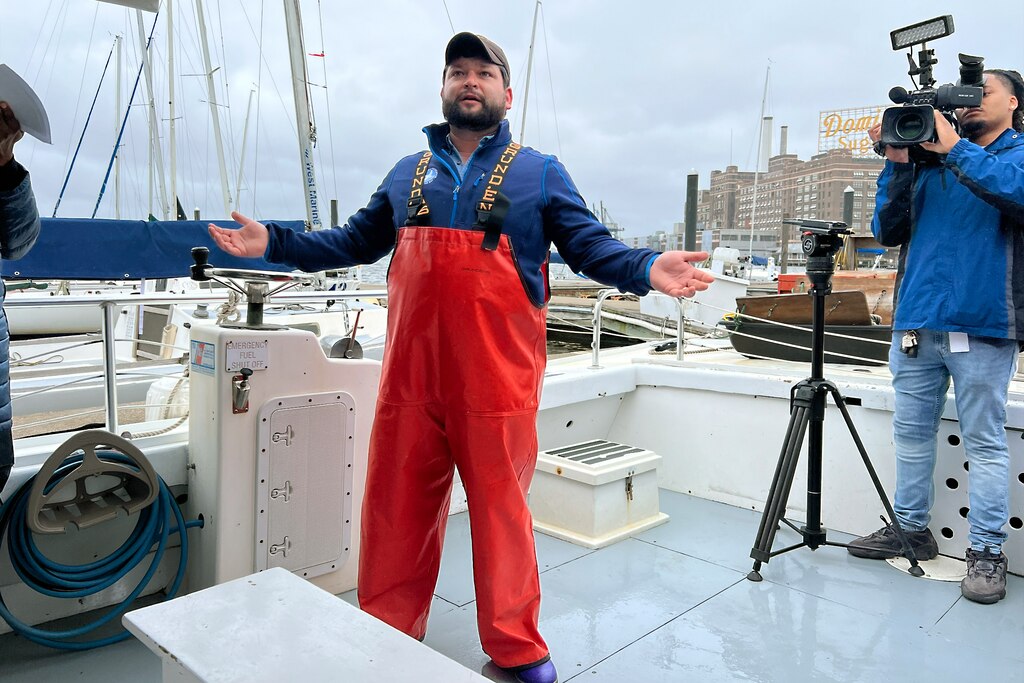About six months after a maritime accident collapsed the Francis Scott Key Bridge, Capt. Ben Carver steered his boat past the wreckage site to the oyster sanctuary he and other environmentalists had fostered nearby, not sure what he would find.
Read More
Carver had been there, at the underwater reef beside Fort Carroll, just beyond the Key Bridge, hours before the March 26 collapse. He and other environmentalists took stock of a vibrant oyster population, which has helped filter and clean the Patapsco River there for the last eight years.
When the wreckage was cleared and he finally had a chance to go back, he expected to find the oysters dead. He was happy to be wrong.
“They’re doing just fine,” said Carver, floating above the two-acre oyster garden on Wednesday evening. “These are resilient little things, doing their goodness.”
The Baltimore Banner thanks its sponsors. Become one.
Carver, captain of a Chesapeake Bay Foundation workboat called the Snow Goose, led members of his conservationist group through chilly rain Wednesday to plant around 31,000 juvenile oysters at the Fort Carroll sanctuary. The foundation only resumed plantings at the site earlier this month due to the bridge disaster. It estimates that it has planted 128,187 new oysters there.
Wrapped in raincoats, a group of Bay Foundation scientists and reporters huddled on the Snow Goose beside baskets with thousands of nine-month-old oysters, barely the size of pennies and clinging to recycled shells.

In the world of marine conservation, oysters are humble stars.
Once so abundant in the Chesapeake that ships had to navigate around towering reefs, they serve as both food and habitat for fish, crab and underwater life. Oysters are also little vacuum cleaners for the bay, filtering harmful algae and preserving oxygen for other creatures to breathe.
“They’re by far the best filter that we have in the Chesapeake Bay,” Kellie Fiala, the Bay Foundation’s Maryland oyster restoration coordinator, said as the Snow Goose hummed past Fort McHenry.
The Baltimore Banner thanks its sponsors. Become one.
The foundation, the largest environmental group dedicated to restoring the Chesapeake, works with corporations and other groups in Baltimore to grow baby oysters — known as spat — on recycled shells in hundreds of cages around the harbor. All of the oysters on board Wednesday sprouted along the docks of Domino Sugar, Ports America or tug and barge company Vane Brothers.
During the planting season in the wake of the bridge collapse, the Bay Foundation had to take Baltimore’s oysters to the Magothy River north of Annapolis, only returning to Patapsco sanctuary earlier this month.
An underwater view of an oyster reef near Fort Carroll (Rick Younger/Chesapeake Bay Foundation)
There was some question on the Snow Goose about how to describe these young oysters, which were a little too old to call babies anymore.
“These are juveniles,” said Morgan Shapiro, Baltimore oyster restoration coordinator for the Bay Foundation.
The Fort Carroll sanctuary is a small part in a years-long effort to rebuild the bay’s oyster populations after two epidemics, one in the 1980s and another in the early 2000s, decimated the population, pushing them to what scientists believe was their lowest count ever in 2005.
The Baltimore Banner thanks its sponsors. Become one.
It seems to be working. Fiala said the garden off Fort Carroll is now home to some six million oysters.
At the same time, the Maryland Department of Natural Resources released a stock assessment this week that found the population of adult oysters across the bay has tripled from their 2005 low.

Mike Wilberg, a University of Maryland Center for Environmental Science professor who led the assessment, said a combination of a couple good spat years and a run without the kind of disease outbreaks of the 1980s and ‘90s has seen the population grow from 2.4 billion in 2005 to 7.6 billion at the end of 2023.
The stock assessment focused on areas where oysters can be harvested, not sanctuaries like the one at Fort Carroll, and Wilberg said state restrictions on harvesting have allowed many of these mollusks to remain in the water, filtering and reproducing. After another strong spat year in 2023, he expects the population to keep growing in the next few years.
Still, the Chesapeake’s oyster population is nowhere near its peak. There were once so many that they could filter all the water in the bay in a week or less, Fiala said. That now takes about a year.
The Baltimore Banner thanks its sponsors. Become one.
The Bay Foundation and its partners at the Chesapeake Oyster Alliance have a goal to plant 10 billion oysters by the end of this year. To date, they’e planted about 6.7 billion, Fiala said.
The Snow Goose puttered through the rain for less than an hour before gliding beyond the concrete pylons of the now gone Key Bridge and stopping over the sanctuary beside the abandoned fort.

It’s a testament to the young oysters’ understated power that their journey ended anti-climactically.
As the Snow Goose bobbed, passengers took turns hoisting baskets and dumping oysters over the edge.
They entered with a soft splash and sank silently into the murky water.





Comments
Welcome to The Banner's subscriber-only commenting community. Please review our community guidelines.